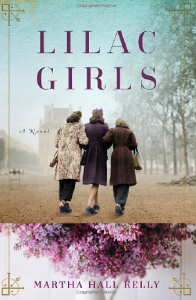 Lilac Girls
Lilac Girls
By Martha Hall Kelly
New York: Ballantine Books 2016
A novel about Ravensbrück? My first reaction was negative. But it’s hard to resist opening a book once it’s in front of me and the opening chapters did little more than arouse my curiosity. And curiosity doesn’t leave one in peace until it’s satisfied.
I knew a lot about Ravensbrück and the medical experiments performed on Polish girls—most of them in their teens, members of the scouts who had joined the Resistance—but I had never heard of Caroline Ferriday, a New York socialite who brought these women to America for treatment.
Luckily, Martha Hall Kelly has recovered a great story about a warmhearted, generous woman who should never should have been forgotten. Kelly fills her book with many details, a deep understanding of the terrible occupation imposed in Poland, and the unfair post-war situation created by what had been Poland’s allies.
Kelly tells the story with three parallel narratives, one by a Polish teenager, one by Ferriday, and the third by Herta Oberheuser. It’s an interesting approach but confusing at first because they all seem to speak in the same, decidedly American, voice.
Still, the story is so gripping that I continued; eventually the three voices not only became distinct but the justification for writing this way became apparent. By having the narrators speak in an American idiom, readers can connect with them, even identify with them. This is important because Kelly’s book, while containing fictional details, is about very real people, real historical events, and terrible crimes.
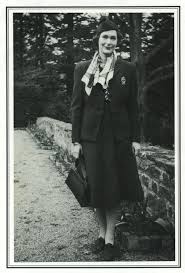
Caroline Ferriday
The story begins with Caroline Ferriday, a wealthy Francophile and the first narrator who is involved in charitable efforts on behalf of French orphans. For her, Kelly adds a fictional element of romance. Not too much to be intrusive.
Far from Ferriday’s life of fun and luxury, Kasia Kuzmerick’s story unfolds in occupied Poland where the 17-year old’s school is closed and she joins the resistance. She is ultimately arrested, together with her sister, a doctor, and her mother. Unlike Ferriday, Kuzmerick is a fictional character, a composite based on actual Ravensbrück prisoners, some of whom the author met during a research trip to Poland. While Kasia is invented, the historical details are not.
The third character, like Ferriday, is not fictional. Herta Oberheuser, an ambitious surgeon totally committed to Nazi ideology and German war aims, performed hideous experiments on healthy young Polish women. She volunteered for Ravensbrück to further her career,
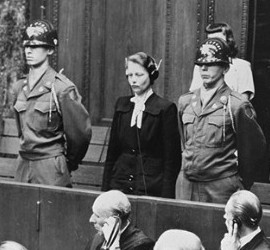
Dr. Herta Oberhauser
convincing herself that her work was essential for Germany’s interests. After the war, she expressed no remorse and served only one year of her 20-year sentence in prison before resuming her medical practice.
A former copywriter for an ad agency, Martha Hall Kelly couldn’t have chosen a more difficult subject for a debut novel. Or perhaps it chose her. She once lived three-hours away from the Ferriday family estate, “The Hay,” and went to visit it, primarily because of her interest in lilacs. While there, she noticed a photograph of Ferriday with three other women. She asked the guard who they were and when told they were Polish women who were once prisoners at Ravensbrück, and that Ferriday had brought a large group of them to America to get medical treatment for the painful debilitating effects of the medical experiments they endured, Kelly knew immediately this was a subject she had to pursue.
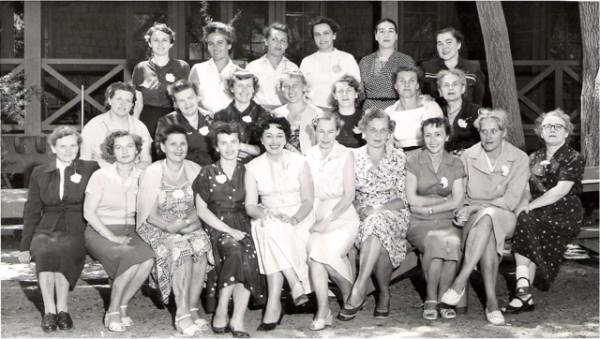
Group photos of Ravensbrück survivors at “The Hay”
She researched her book for ten years, in all three Ferriday archives—in France, New York and the family Connecticut estate—and travelled to Poland where she visited the Muzeum Martyrologii pod Zegarem (Museum of Martyrdom Under the Clock) in Lublin. There she met the museum director, Barbara Oratowska, who facilitated Kelly’s research. Later, in Warsaw, she met and interviewed former Ravensbrück prisoners and survivors of the experiments, as well as historians of this era who assisted her in this undertaking.
Among the many surprising Polish details in the book is a reference to Szatan z siódmej klasy (Satan from the Seventh Grade), a popular book for school children that I had long forgotten. Kelly discovered that the secret letters the Ravensbrück prisoners sent to inform their countrymen about the experiments were written in invisible ink by using a toothpick and urine, inspired by the invisible ink used in Szatan, though in that case lemon juice was used.
After the war, Ferriday went to France several times, continuing her work with French orphans. While there, she learned about the Polish women subjected to experiments, and discovered that they received no support from Germany. She was aware of the devastation Poland had suffered and knew that conditions under Moscow-imposed communism were dire.

Dr. William Hitzig examining a Ravensbrück survivor
Back home, she embarked on a plan to bring the Ravensbrück lapins (experimental rabbits) to America to get them the best possible medical help for physical and mental rehabilitation. With her social network mobilized, she raised the funds for their travel and found homes for them during their treatment in America. Some Ravensbrück women stayed with her at The Hay, and they remained her lifelong friends. She also persuaded top doctors to undertake the work, among them Dr. William Hitzig who travelled to Poland with Ferriday to evaluate the women’s medical needs.
After the women returned to Poland, Ferriday continued to lobby her influential friends to insist that Germany provide the Ravensbrück survivors with support. She located Dr. Oberheuser, living comfortably and practicing medicine, and lobbied the American government to force Germany to revoke her medical licence.
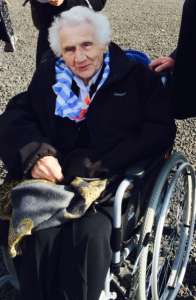
Mrs. Stanisława Sledziejewska-Osiczko
Among the photos sent by the author is one of Mrs. Stanisława Sledziejewska-Osiczk, one of five survivors of the experiments still living. Martha Hall Kelly met her and describes her as loving and forgiving. It is the courage and the ethos of such people that must be a guide to the future if we want a better world. The nationalism and ideology of Poland’s oppressors, with their racism, nationalism, intolerance of different opinions and religions, and their thirst of revenge and domination brought about the terrible suffering and death toll that will forever mark the 20th century as one of unbridled evil.
Martha Hall Kelly has done a great service bringing attention to this wonderful American woman, the “Ravensbrück godmother.” It is surprising that she is almost unknown, even among the Polish-American community. Posthumous recognition is in order. But not a monument—an inanimate object wouldn’t do justice to the very energetic Ferriday—but an annual lecture at a university, or an annual cultural event at a Polish-American Foundation would keep her memory alive, and that of the Ravensbrück prisoners, while inspiring others to follow her example, would be perfect.
And Ms. Kelly has also honored Poland and Polish people by bringing this little-known story once again to our attention. For decades Poland’s history was neglected, when not actually distorted by Soviet propaganda. It is time to write it and teach it, always with a view to a better future.

The Ferriday estate, “The Hay”
Curious about the press coverage of this story at the time, I asked CR’s Maureen Mroczek Morris, who can find the most obscure newspaper stories imaginable. She located a few. Of special note is the May 31, 1959 New York Times article by Howard A. Rusk, M.D. who sharply criticized as “eminently unjust” Germany’s failure to pay the survivors any compensation. Rusk also praised Caroline Ferriday’s initiative and the generous American donation of funds, as well as medical, dental, psychiatric and rehabilitation services.
CR


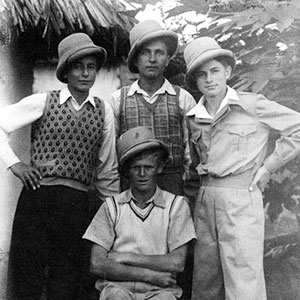

Irene, thanks for an excellent review. The story of the Ravensbrück rabbits undeniably needs to be publicized. I’m definitely getting the book.
Pingback: Welcome to Spring 2016!
Thank you for this lovely review, Irene. You captured the book so beautifully.
I just finished reading this very sad story told so well by the author. I bought it at Barnes and Noble based on reading the inside cover. I knew absolutely nothing about this story of terror and horror. I just kept thinking to myself that this just does not feel like a book that is entirely made up! Of course, I found the answer at the end of the book and it all made sense. This is a story which definitely was needed to be told, and I am going to recommend it to all of my friends!
Thank you!!!!
Dzien kuje, Irene Tomaszewski,for this thoughtful and insightful review. I give major props to the author, Martha Hall Kelly, for her many years of commitment to what I imagine was a labor of love. The world certainly needs to learn this sad, but important, history. I definitely plan to purchase the book soon.
Listened to Lilac Girls, a book on tape sent to my sister who is blind. It is a book that inspires us to cherish our people and our country. May the Polish history continue to be known.
Listen to an interview with the authour on POLcast – wwww.mypolcast.com: http://www.mypolcast.com/2016/08/episode-18/
and get a lot more info here: http://www.mypolcast.com/2016/08/a-story-that-needed-to-be-told-lilac-girls-episode-18/
I loved this book . I read it in two days. Even if the story is sad and it is terribly true, it’s so well written that You can’t stop reading it. I read it in Italian and the Italian title is ‘ The girls with no name’ that brings You immediately in the central atmosphere off the book.
Teachers should read it and speak about this topic in schools.
Thank you Martha Hall Kelly! The Lilac Girls was masterfully written and a story that should be widely shared.
Thank you Martha for this great and moving story!
I feel very blessed reading your wonderful, heartbreaking novel.
I love it!
Thank you Martha for this very sad story which really made an impact on me. Having been born and raised in the Netherlands i knew a lot about Ravensbruek but not about the lapins. I have just read it here in New Zealand and taking it to my book club to share next month. The coordinator is just reading it as well so it will generate some good discussion. I will also recommend it to my sister who lives in Virginia.
Thank you Martha Hall Kelly for writing this book. What a story that needed to be told. My husband and I listened daily on our trips to and from work this winter. We are both of Polish decent. My own mother never heard this story and she came of age during the war. What a read! Looking forward to you next work and hopefully more on this topic or similar topics.
My book club assigned this book for our next meeting. I was not happy about the choice because there have been so many holocaust related stories to read as of late, and it hurts my heart to read them. Having said that, I read Lilac Girls and loved it. I found it so uplifting even with the subject matter. I’m from Connecticut, not far from Bethlehem. I’ve looked up Caroline’s house online and will visit come May when tours begin and flowers are in bloom. Thank you, Martha, for allowing me to meet some outstanding women!
I would like to thank Miss Kelly, as, thanks to her book, I couuld know many things till now unknown. the book is really interesting and after having it finihed, I’ve started again to read it, just because of I wanted to teste it better. It is true! it is one of best book talking about nazi what I’ve read! Iìm also interested to sequel! is it already printed in italy?
Pingback: ‘Lilac Girls’- Martha Hall Kelly – Bookish1028
As an Australian male, I found this book extraordinary and very moving. At times I had to put it down while travelling in the train because it impacted on me so much. I was ignorant of the atrocities of Ravensbruck and the strength of the Polish women and am glad that it has been revealed at last in such a gripping and non-sensationalist way.
Thank you❤️We must not forget
I just finished Lilac Girls having stumbled upon it while looking for books to read on my kindle. Thank you to the author, Ms Kelly, for bringing Caroline Ferriday’s amazing life and the story of the young Rabbits to our attention.
This story should never be forgotten.
Dear Irene,
Thankyou for this excellent editorial review. I’m glad to see you clarify the American voice in which The book is written. Sometimes when American authors do so, it is a distortion of Polish reality, esp.during those terrible times. Foe ex., Kasia, a composite character of the Polish women drawn from the experiences of their torture and suffering, refers to her mother as “Matka,” rather than “Mama,” or “Mamusia,” as any native Polish girl would do. Also, in the mispellings of Polish surnames, those of which end in -ski, are shown as -sky, which is Russian or Ukrainian, not Polish spelling. These seemingly small errors surprised me, and I wondered where the author’s editorial assistance had failed. But then as i was reading, i saw that none of them were Polish. I guess that’s why.
Even so, the author succeeds in getting her audience to relate to the characters in a gripping pageturner, and I thank her for honoring Poland this way by bringing to light history that has been obscured too long.
Thankyou both!